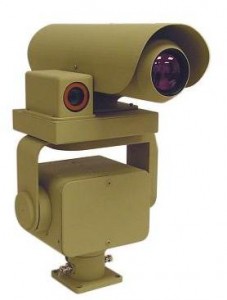THERMAL IMAGING
Over the years, the use of thermal cameras has expanded. Once widely used only for surveillance and security, the current technology has made these cameras serve many other useful purposes. The infra red technology which detects heat energy can detect the minute temperature changes and this is generated as an image on a screen. The thermal imaging camera can easily identify hot or cold spots by measuring surface temperature variations. These cameras create pictures made of heat exposure rather than light. The heat energy in any live human or animal is detected and converted into a picture form. However, the picture resembles an irregular circle of varying colors and shapes. All thermal imaging cameras have infrared detectors.
They are Thermo graphic Cameras which uses Infrared Radiation as Visible Light. A thermal imaging camera consists of five components:
1) An optic system.
2) Detector.
3) Amplifier.
4) Signal processing.
5) Display.
PRINCIPLE: any object whose temperature is above 0’K will radiate infra red energy. This infra red energy is detected with the thermal camera and then using sophisticated computer software, this is converted into an image which can be visible on a screen. The camera display shows infrared output differentials, so two objects with the same temperature will appear to be the same “color”. Many thermal imaging cameras use grayscale to represent normal temperature objects, but highlight dangerously hot surfaces in different colors.
Since thermal imaging cameras can “see” through darkness or smoke, they allow Security Personal to quickly find the heat signature of visually obscured victims and culprits. The latest design of thermal imaging cameras used by military offers complete flexibility and operator safety. These cameras are easy to use and can be set up in a matter of minutes. Many of the cameras also have wireless transmission and a central video monitoring.
The process by which a thermal imaging camera transforms thermal energy into visible light consists of five basic steps. These steps are:
- Utilize a specially designed lens to focus the infrared radiation that is given off from all objects within the field of view of the camera lens.
- Infrared detectors are then used to scan this focused radiation. The detectors create what is called a thermogram, or temperature map.
- The thermogram is then translated into electric impulses.
- The electric impulses are then sent to a signal-processing unit where they are translated into data. The signal-processing unit is a tiny chip that is embedded on a circuit board, which is used to translate the electric impulses into usable data.
- Once translated, the signal-processing unit sends the data to the display where it then becomes visible to the viewer.
There are two basic types of thermal imaging cameras, un-cooled, and cryogenically cooled. Most thermal imaging devices are un-cooled. This simply means that the camera itself functions without an additional cooling unit attached. A cryogenically cooled thermal imaging device on the other hand, is much more expensive, but produces a much clearer image and is much more sensitive to temperature variations. This means the corresponding image contains much more detail and depth.








October 29th, 2010 at
[…] This post was mentioned on Twitter by iWatchSystems LLC, Ron Gibson. Ron Gibson said: THERMAL IMAGING http://dlvr.it/7kytl […]